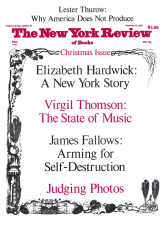While there have been many rich descriptions of the life—and the nowchanging times—of the !Kung of south central Africa, this account by Marjorie Shostak, a Harvard anthropologist, is noteworthy for its focus on a single person. Nisa (the name is fictitious) is a woman now sixtyish, forthcoming in personality, and unabashed and expressive in her native tongue (which Shostak painstakingly learned in order to conduct her investigations). The result is the narrative of an idiosyncratic life, but one that mirrors the conventions and culture of a group as well.
The portrait is unsentimental. Shostak even reports her own early ambivalent feelings about Nisa, whose demanding, manipulative behavior, along with her constant reminders of the generosity of past anthropologists, were not likely to endear. After a while, however, Shostak and Nisa both changed. The anthropologist interviewed more than a dozen women of all ages—inviting recall, asking pertinent questions, seeking bio-graphical highlights. Nisa emerged as particularly forceful, colorful in language, and generally truthful.
Each chapter begins with a broad view of the stage or age about to unfold, based on other sources and interviews. Then we focus on Nisa, starting with her earliest memories of weaning and of the near-infanticide of her younger brother (a rare event, we’re assured). We learn of a free-wheeling childhood, of seasonal comings and goings; child marriages; the first menstruation and attendant rituals; of childbirth, in the bush, unattended.
If the narrative is highly charged with sex it is because sex is important in !Kung life. Marriages are largely monogamous, with some sanction for a second wife; lovers are accepted for both husbands and wives, but discretion is important—discovery can lead to mayhem and even murder. Some cultural details we have heard before from Richard Lee or Irven DeVore*—the elaborate gift-exchanges, the bounteous mongongo nut, the meat-sharing, the canny skills (the ability to recognize an individual’s tracks, for example), the storied botanical and animal lore. Shostak sees some potential advantage in the !Kung’s preserving their rituals, healing rites, drum dances, stories, even as domestication takes place and the people begin to cultivate their gardens, to crave tobacco and money. Time will tell. For now we have a remarkable anthropologist to thank for an absorbing account of the far-from-happy life of a woman of admirable strength and self-possession.
It is pleasant to report that Needham—now in his eighty-first year—has written another magnificent book. In five scholarly lectures he presents some of the fruits of forty-three years’ labor aimed at chronicling the history of science in China; as a group, they serve to introduce the general reader to the charm of Needham’s style and to material as fascinating as it is unfamiliar. A long introductory lecture discusses practical versus theoretical thinking East and West. “Metaphysical idealism was never dominant in China, nor did the mechanical view of the world exist in Chinese thought.” Instead, Needham finds a kind of organic wholeness that led the Chinese to make practical inventions at the same time as they were theorizing about stars, space, and action at a distance. (Though algebraic in mathematical thought, not geometrical, the Chinese were perfectly capable of making elaborate gears, clock escapements, and other devices dependent on rotary motion.)
A longish chapter on gunpowder records the earliest Chinese alchemical discoveries and debunks the notion that the Chinese used gunpowder only for fireworks. A chapter on macrobiotics—literally the art of long life—makes the point that, in China, the idea of transmuting minerals to gold was never divorced from the idea of using minerals to achieve immortality, or at least to heal ills; in the West, Needham remarks, comparable ideas only began to flower with Paracelsus. Acupuncture and moxibustion (the burning of special sticks on or above selected points on the skin) are the subjects of the fourth lecture in which Needham, trained as a biochemist, guardedly defends acupuncture on grounds that the needles tap into the body’s own endorphin-mediated pain-suppression systems.
In his last chapter, Needham singles out China as dominated more by linear, progressive notions of time than by repetitive cycles (or the eternal return) as in post-Hellenic and Indian cultures: a difference often noted in comparisons of East and West. He cites China’s sense of history, its reverence for past masters and inventors, its progression in science toward greater accuracy—overall, the idea that knowledge is cumulative. Why then did China stand apart from the burst of modern science that took off in the West after Galileo? Here Needham has little to say, alluding obliquely to the unbroken mandarin bureaucracy able to absorb and assimilate; the concept of the slow and steady versus the climactic and cataclysmic history of the West. This is an absorbing and stimulating book, an introduction that will encourage readers to turn to Needham’s five-volume Science and Civilization in China.
Advertisement
This Issue
December 17, 1981
-
*
Richard B. Lee, The Kung San: Men, Women and Work in a Foraging Society (Cambridge University Press, 1979), and Richard B. Lee, Irven DeVore, eds., Kalahari Hunter-Gatherers: Studies of the Kung San and Their Neighbors (Harvard University Press, 1976).
↩



